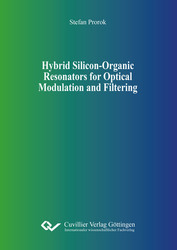| Areas | |
|---|---|
| Serie de libros (96) |
1349
|
| Nachhaltigkeit |
3
|
| Gesundheitswesen |
1
|
| Letra |
2345
|
| Ciencias Naturales |
5384
|
| Matemática | 227 |
| Informática | 318 |
| Física | 978 |
| Química | 1360 |
| Geociencias | 131 |
| Medicina humana | 243 |
| Estomatología | 10 |
| Veterinaria | 102 |
| Farmacia | 147 |
| Biología | 833 |
| Bioquímica, biología molecular, tecnología genética | 119 |
| Biofísica | 25 |
| Nutrición | 45 |
| Agricultura | 1000 |
| Silvicultura | 201 |
| Horticultura | 20 |
| Ecología y conservación de la tierra | 146 |
| Ciencias Ingeniería |
1766
|
| General |
95
|
|
Leitlinien Unfallchirurgie
5. Auflage bestellen |
|
Erweiterte Suche
Hybrid Silicon-Organic Resonators for Optical Modulation and Filtering (Tienda española)
Stefan Prorok (Autor)Previo
Indice, PDF (47 KB)
Lectura de prueba, PDF (94 KB)
This thesis shows that silicon resonators that are infiltrated with nonlinear polymer fulfil the requirements of modern electro-optic modulators such as a small footprint and a large modulation bandwidth. The three major challenges of this hybrid approach are addressed. The first part of this thesis shows that bleaching of a chromophore doped polymer cladding can be used as trimming mechanism in order to compensate random shifts of the resonance frequency during fabrication. In the second part it is described how electro-optically tunable photonic crystal resonantors with high quality factors can be realized. Finally the problem of low electro-optic coefficients inside the polymer for integrated silicon structures is addressed.
Diese Arbeit zeigt, dass Siliziumresonatoren, die mit nichtlinearem Polymer infiltriert sind, die Anforderungen an moderne elektro-optische Modulatoren, wie eine geringe Grundfläche und hohe Modulationsbandbreiten, erfüllen. Der erste Teil dieser Dissertation zeigt, dass das Bleichen einer Chromophor dotierten Polymerdeckschicht als Trimmmechanismus genutzt werden kann, um herstellungsbedingte Schwankungen der Resonanzfrequenz auszugleichen. Der zweite Teil beschreibt, wie elektro-optisch verstimmbare photonische Kristallresonatoren hoher Güte realisiert werden können. Im letzten Teil dieser Arbeit wird das Problem niedriger elektro-optischer Koeffizienten des Polymers in Siliziumstrukturen behandelt.
| ISBN-13 (Impresion) | 9783954049523 |
| ISBN-13 (E-Book) | 9783736949522 |
| Idioma | Inglés |
| Numero de paginas | 156 |
| Laminacion de la cubierta | Brillante |
| Edicion | 1. Aufl. |
| Lugar de publicacion | Göttingen |
| Lugar de la disertacion | Hamburg-Harburg |
| Fecha de publicacion | 27.03.2015 |
| Clasificacion simple | Tesis doctoral |
| Area |
Física de materia condensada ( incluyendo física de cuerpos solidos, optica)
Telecomunicaciones e ingeniería de comunicaciones |
| Palabras claves | Silicon Photonics, integrated optics, electro-optic polymers, electro-optic modulation |








